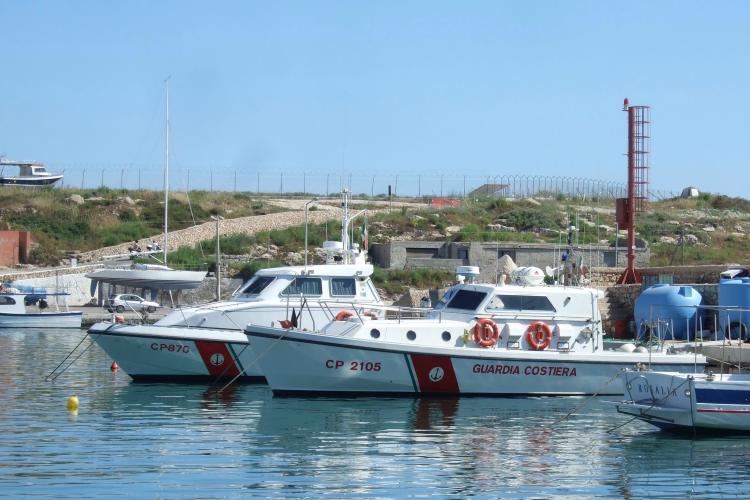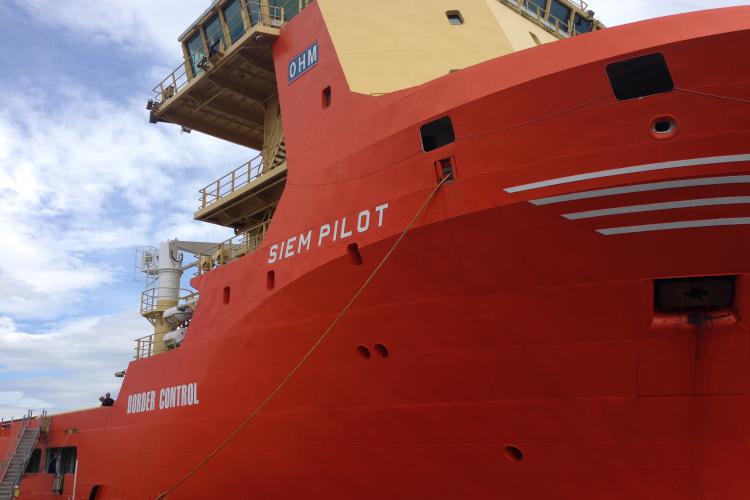Pushing Migrants Back to Libya, Persecuting Rescue NGOs: The End of the Humanitarian Turn (Part II)
PART II
Posted:
Time to read:
Guest post by Paolo Cuttitta, Researcher at the Amsterdam Centre for Migration and Refugee Law, Vrije Universiteit Amsterdam. His most recent articles focus on humanitarianism and human rights, as well as on search and rescue NGOs, at the Central Mediterranean EU border.
In the first part of this post, I, first, described the establishment of a humanitarianized space of the sea between Italy and Libya after the 2012 ECtHR judgment and the 2013 Lampedusa shipwreck. Then, I showed how the EU, Italy and other European countries gradually moved away from humanitarian concerns: by enhancing cooperation with Libyan authorities, by terminating governmental SAR missions, as well as by focusing on border control operations and de facto restricting their operational areas. In this second installment, I show that SAR NGOs have been increasingly exposed to harassment from the Libyan authorities, as well as to restrictions from the Italian ones. I further address the three points that make the Open Arms case unique, namely Italy’s claims that: a) Libya can coordinate SAR operations autonomously; b) the Open Arms acted in breach of the code of conduct; c) the Open Arms should have brought the rescued to Malta. In doing so, I argue that Italy can be held legally accountable for push-backs carried out by the Libyan Coast Guard, that the code of conduct has little if any relevance, and that trying to involve Malta means increasing the death risk at sea.
Harassing and discouraging NGOs
After the retreat of Italian and EU vessels described in the previous blog post, Libyan authorities started hampering NGOs. In April 2016, Libyan officials boarded and searched a vessel of the German NGO Sea-Watch; in August, they shot at, boarded and searched an MSF ship; in September, they seized a speedboat and detained two volunteers of the German NGO Sea Eye. In October, Libyan officials interrupted a rescue operation that was being carried out by a Sea-Watch vessel, causing the drowning of up to 20 people. Aggressions and acts of hostility continued in 2017. The most blatant occurred on 6 November, when a Libyan intervention, disregarding the instructions from Italian authorities, resulted in the death of five people. Italian and European institutions didn’t publicly condemn Libya’s act of piracy, despite having been very vocal in their criticism towards SAR NGOs in previous months.
In the spring of 2017, Catania’s public prosecutor made headlines by declaring that some NGOs may be not only collude with but may also be funded by smugglers. They may even have hidden political aims to destabilize the Italian economy through the uncontrolled inflow of migrants, he said. Preliminary investigations against SAR NGOs were opened by the courts of Trapani and Palermo.
A few months later, in July, the Italian authorities asked SAR NGOs to sign a code of conduct, a controversial document with little if any juridical relevance. Indeed, as a private agreement, it cannot trigger any obligation contrasting with existing national and international law, based on which the duty to save lives always prevails. Furthermore, many of its provisions are redundant. Finally, insofar as it sets unnecessary limits to the activity of rescue ships, the code also seems to contradict the legal obligation of state authorities to avail themselves of any available asset to the maximum extent possible.

On 2 August, only two days after the German NGO Jugend Rettet had refused to sign the code, its vessel Iuventa was seized by the Trapani court, claiming there had been contacts between the NGO and smugglers. While accusations seem to rest on weak foundations, a court should decide on the release of the NGO vessel on 23 April. In this climate of hostility, several NGO vessels abandoned the Mediterranean – among them MSF’s Bourbon Argos and MOAS’ Phoenix.
Increasingly, NGO vessels were required by the Italian MRCC to refrain from intervening, and to wait for hours for the Libyan Coast Guard to come and return the migrants to Libya. Besides forcing NGOs to witness deportations, the Italian authorities moved away from the extensive interpretation of the term ‘distress’. A situation of distress is what triggers the immediate obligation to rescue according to international law. While the Italian authorities, as part of their ‘humanitarian turn’, had adopted an extensive interpretation – assuming that any unseaworthy or overcrowded vessel is ipso facto in distress – in 2013, other states follow more restrictive ones. Abandoning the extensive interpretation of ‘distress’ would likely increase the death toll.
Italy’s legal accountability for push-backs
In May 2017, the Italian MRCC decided for the first time to entrust a Libyan patrol boat with the ‘on scene command’ of a rescue operation, even though a Sea-Watch vessel was already on the rescue scene. While maintaining remote coordination of the SAR event, the Italian MRCC thus allowed the Libyans to return nearly 500 people from international waters to Libya; the NGO vessel would have brought them to a place of safety, as required by international law.
‘On scene command’ means that the relevant vessel should coordinate the other assets on the rescue scene, whereas the MRCC remains in charge of the general coordination. In the absence of other rescue vessels in the area the Italian MRCC may have no other choice than to involve Libyan authorities. However, it remains responsible for identifying the place of safety where the rescued should be disembarked. Allowing returns to Libya may therefore be in breach of the principle of non-refoulement. When one of these boats is an Italian Navy ship, as it was the case on 27 September 2017, the violation of the non-refoulement principle appears even clearer.
To circumvent legal responsibilities, Italy now claims that its MRCC did not just grant ‘on scene command’ to a Libyan boat on 15 and 31 March, but rather transferred the general coordination to its Libyan counterpart. However, there is no such thing for, as Italy and the EU have just started supporting Libyan authorities in their efforts to establish their own MRCC. Even the Catania court recognized that Libyan interventions are coordinated by the Italian Navy through its Tripoli-based warship.
As long as a country does not have an effective MRCC, it cannot have a SAR region. Therefore, Libya’s notification to the International Maritime Organization (IMO) in August 2017, claiming a large SAR region off its coast, following which Libyan authorities had warned NGO vessels not to enter its SAR region, was eventually withdrawn in December. The fact that a Libyan SAR region doesn’t exist yet was also confirmed by Frontex’ director Leggeri recently.
Moreover, regardless of the existence of a Libyan SAR region, Italy could be held responsible for aiding or assisting another state in committing an internationally wrongful act in violation of the principle of non-refoulement. Italy’s complicity derives from having provided the Libyan authorities with training, patrol boats and technical support, knowing that this would result in push-backs.
While Italy’s intention is to circumvent the ban on push-backs imposed by the 2012 ECtHR judgment, there seems to be enough evidence to argue that Italy is again violating international law. Therefore, lawyers call for an involvement of the UN Security Council, the International Criminal Court and the European Court of Human Rights.
Malta’s involvement: Increasing risks for rescuers and migrants
Until 2013, there had often been struggles between Italy and Malta, and sometimes other countries, about where rescued migrants should disembark, or who should carry out a rescue. Commercial and military vessels rescuing people within the Maltese SAR region were refused permission to dock, and had to wait for days before being allowed to land elsewhere. Indeed, Malta maintains it has no such obligation, since it never signed the 2004 amendments to the 1974 Convention for the Safety of Life at Sea, according to which the country responsible for a given SAR region is also responsible for ensuring that a place of safety is provided for those rescued there.
These incidents, with ship-owners bearing the costs of long waiting times and route diversions, contributed to the increasing indifference of seafarers towards migrants in distress: survivors often report that fishing boats or cargoes deliberately did not stop to assist them.
Indifference towards people in distress at sea also involved state authorities on several occasions. The shipwreck of 11 October 2013 is exemplary. That day, short after the Lampedusa tragedy, the Italian MRCC received a distress call from international waters. An Italian navy ship was very close to the boat in distress. However, because the call came from the Maltese SAR region, the Italian officials passed the buck on Malta, and didn’t mention the Italian navy ship. In turn, their Maltese colleagues objected that the boat in distress was much closer to Lampedusa than to Malta. In the end, 200 Syrians died because of the delay in launching a SAR operation. Two Italian officials are currently on trial on the charge of manslaughter.

After the shipwreck, Italy took up the coordination of all SAR operations in the Southern Central Mediterranean. Moreover, Malta was not asked to take rescued people, except for medical evacuations. First, because patrols close to Libyan waters resulted in rescues mostly occurring outside the Maltese SAR region. Second, because the operational plans of both Italian and EU missions ruled that the rescued should be brought to Italy anyway.
Since last summer, however, things have changed. In August 2017, the Italian authorities argued that the people rescued by Proactiva Open Arms’ ship Golfo Azzurro under their coordination should be brought to Malta, because the rescue had taken place in its SAR region. Malta refused, and the Golfo Azzurro had to wait for three days before it was allowed to dock in Sicily.
Furthermore, the new Frontex operation Themis, which replaced Triton in February 2018, removed the obligation to bring rescued people to Italy. They will be taken to the nearest port of safety, which could possibly be Malta.
By accusing the Open Arms not to have brought the rescued people to Malta on 15 March, Italian authorities are reactivating the old vicious circle: increasing the risk for the rescuers also means increasing the risk for those to be rescued, and vice-versa.
Conclusion
Italy, with the support and active cooperation of the EU, has gradually and radically transformed the seascape of interceptions and rescue operations between Sicily and Libya in recent years. While several NGOs keep patrolling the Southern Central Mediterranean despite the growing challenges, and the Ragusa court decided to lift the seizure of the Open Arms on 16 April 2018, the governmental humanitarian turn of 2013 has clearly come to an end. For Italian authorities, NGOs have turned from partners to competitors, and Libyan authorities are carrying out push-backs on behalf of Italy. While Italy could be held legally responsible, the EU and its member states clearly bear a heavy political responsibility, too.
Any comments about this post? Get in touch with us! Send us an email, or post a comment here or on Facebook. You can also tweet us.
__________
How to cite this blog post (Harvard style)
Cuttitta, P. (2018) Pushing Migrants Back to Libya, Persecuting Rescue NGOs: The End of the Humanitarian Turn (Part II). Available at: https://www.law.ox.ac.uk/research-subject-groups/centre-criminology/centreborder-criminologies/blog/2018/04/pushing-0 (Accessed [date]).
Share:








